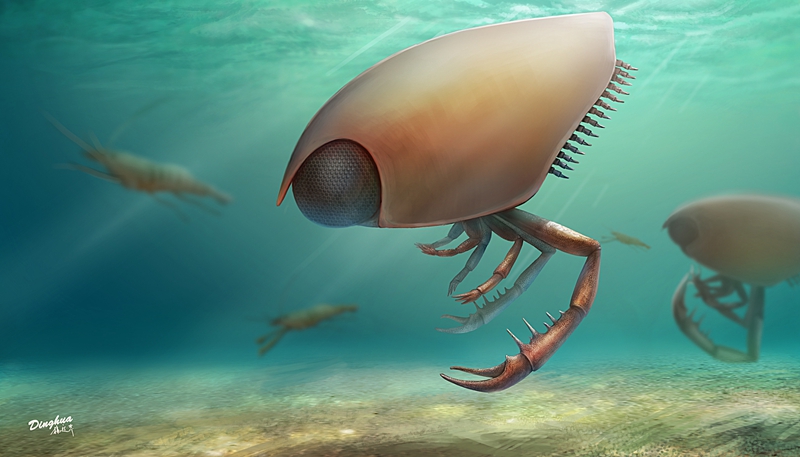
Ankitokazocaris chaohuensis. scale bars equal 5 mm
Thylacocephala, though only been recognized for 25 years, has been considered a peculiar group worthy of detailed anatomical and phylogenetic studies. They are benthic arthropods showing large, laterally flattened ovoid/sub-trapezoidal bivalved carapace that encompasses the entire body and have a typical anterior rostrum-optic notch complex. Generally they have large compound eyes, three large raptorial appendages, 8 gills and numerous posterior appendages. Their long temporal distribution, from the early Palaeozoic to the Late Cretaceous, is furnished by patchy records that clearly reflect the availability of Fossil-Lagerstätten. The taxonomy and ecology of this group has been controversial due to the low diversity and lack of complete specimens.
In the Chaohu Area of Anhui Province, a complete strata of the Early Triassic can be observed. The Chaohu Fauna, represented by the diversified marine reptiles and fishes from the upper part of Nanlinghu Formation (Spathian, Olenekian), has been regarded as a marker of the full recovery of marine ecosystem after PTME. Recently, Dr. JI Cheng from Nanjing Institute of Geology and Palaeontology, Chinese Academy of Sciences and her collegues discovered new material of thylacocephalan from the Chaohu Fauna and it is also the first report of this group in the Triassic of South China. More than one species can be recognized but majority belongs to a new species, Ankitokazocaris chaohuensis, suggesting a close geographic correlation with Madagascar and Japan during the Spathian of Early Triassic.
From the bed yielding A. chaohuensis, we also found some coprolite fossils, some of which contain conodonts inside. The size and structure of these coprolites can rule out the marine reptiles and fish from the same fauna as producers. Dr. JI compared the relative size of gut and carapace of Silurian thylacocephalan Thylacares brandonensis and their coprolites and found that these thylacocephalans from the same bed could possibly have produced the coprolites after eating conodont animal. This is the first report of the predation between thylacocephalan and conodont animal. On the other hand, thylacocephalans have large compound eyes and large raptorial appendages, suggesting they are capable of detecting and grasping small prey like shrimp or maybe even conodont animal of similar size. Dr. JI also have a few specimens that preserve conodonts inside the partial carapace where the latter was broken. They might be related with gut remains but still need further evidence.

reconstruction of Ankitokazocaris chaohuensis (By YANG Dinghua from NIGPAS)
This research has been recently published on-line in Paläontologische Zeitschrift, founded by National Science Foundation of China, CAS Key Laboratory of Economic Stratigraphy and Palaeogeography and State Key Laboratory of Palaeobiology and Stratigraphy (NIGPAS).
Reference: Cheng Ji, Andrea Tintori, Dayong Jiang and Ryosuke Motani, 2017. New species of Thylacocephala (Arthropoda) from the Spathian (Lower Triassic) of Chaohu, Anhui Province of China.Paläontologische Zeitschrift, DOI: 10.1007/s12542-017-0347-7.
